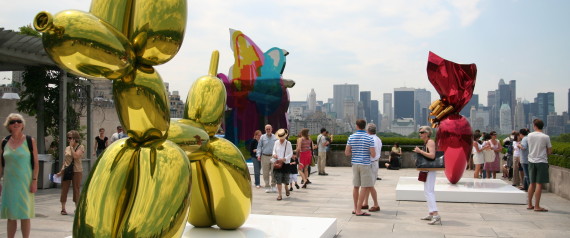Collecting Art: Philanthropy or Self-Glorification?
June 17, 2014

By Olivier Berggruen
See the original article at The Huffington Post
BASEL — The last few years have ushered in a new era in the craze for contemporary art, with prices reaching such dizzying heights that many feel inclined to predict its collapse. Yet, the bubble shows no sign of bursting. Art buying has become the favorite playground of a super-rich elite isolated from the economic realities that shape the lives of most humans.
Events such as high-profile exhibitions, auctions and fairs (with ArtBasel presently underway), testify to the current yet lasting trend whereby the art market seems to be disconnected from a broader economic context. In May, Christie’s sold $750 million of art in just one evening in New York. Over three days, Christie’s contemporary sessions realized close to $1 billion. Impressionist and Modern sales totaled a mere $325 million in comparison. Auction results for Sotheby’s were more modest, but contemporary art alone totaled $461 million.
Though these results are enough to make us wonder about bubbles and how irrational they are (let us remember Tulipomania in 17th century Netherlands), relatively few voices have come out against this latest craze. It seems that to criticize this phenomenon is to be accused of philistinism. Contemporary art in the days of Matisse, Picasso and Duchamp represented the avant-garde, critical of the main currents of society. What has changed since?
That contemporary art has become the playground of the nouveaux riches there can be no question. The spectacle of the packed evening auctions (which not so long ago were black-tie affairs and are now distinctly more loutish) and fairs attended by the wealthy, the louche, and the merely semi-louche, is ample evidence of the successful merchandising of contemporary art to the global elite. Prices paid for the great names of today seem to defy common sense, and pale in comparison to the price of masterpieces by Boucher, Rubens or even Cézanne. A spiral has been unleashed, one that is seemingly without end. Speculation and self-glorification are part of the fabric of today’s complex network of trades in art.
One of the forceful voices that has emerged against the worship of contemporary art is the eminent Australian philosopher and animal rights pioneer Peter Singer. Although Singer professes to like art and encourages its dissemination, he has a threefold critique.
One, contemporary objects are not rare, unique or skilled in the way artifacts from previous generations are.
The second is that artists have sold out. Modern art in the days of the avant-garde was a powerful agent of social change.
The artist, at least since the Romantic era, had been independent from private patronage and had therefore challenged the main forces and status quo of society. Thus, an activity that began as revolutionary, that challenged the margins of society (think of the Picasso of the “Demoiselles d’Avignon” or “Guernica”; think more recently of Joseph Beuys’ utopian notion of changing society through our individual capacity to create art), has now drowned in the mainstream of capitalism, commercialism and marketing.
The last and most powerful of Singer’s argument is that the money lavished on contemporary art (and art in general) would be better spent by supporting pressing causes, such as poverty in the developing world and the eradication of diseases such as child blindness and malaria.
In regards to Singer’s first argument, I believe that rarity is not necessarily a guarantee of quality. Nor is the fact that works are handcrafted. Throughout history, art has adapted to new media and techniques; new and fertile production methods have emerged in recent decades. Moreover, Singer and others seem to be clinging to a debatable definition of art as unique, manual objects; by such a definition, Duchamp’s ready-mades are not art. In more general terms, I would argue that art is an open-ended concept, and there is no essence common to all artifacts.
With regard to the general acceptance towards modern and contemporary art, Singer takes as his example Jeff Koons’s rebellious stance in his younger days, in stark contrast to his current position as the artist consecrated by the art establishment, along with other luminaries such as Hirst, Prince and Kiefer. But prices are notoriously uneven, favoring only a handful of market darlings, and today’s taste may be very different from tomorrow’s. We can remind ourselves with amused indulgence of the vast sums paid in the late 19th century for Meissonnier or Cabanel. However, it seems too facile to condemn the contemporary art world wholesale. Some artists will survive and be glorified in the future; the vast majority will be forgotten. Isn’t it too early to pass judgment?
As to the ethical value of art, in my view there is no simple answer. Needless to say there are many ignorant arts patrons in today’s world, driven by desires that are far from noble and the pursuit of young art for its own sake can do a disservice to the arts community at large. It is not responsible to give young artists the hope that they can make it, and that what they do is worthwhile, just because of an overheated economy.
Much of the art being bought today is not the result of a singular or original vision. The choices reflect those imposed by the forces of the market, and all too often there is little public good in the multiplication of private museums and foundations that serve the self-aggrandizing purposes of their founders. Museums have perhaps rushed too much towards enshrining contemporary art. Today’s production should surely be shown and debated, but by no means sacralized.
On the other hand, museums provide a priceless educational, private and social public good. There is no doubt that much of today’s art is popular: MoMA had nearly 3 million visitors last year; numbers are even higher for Tate Modern. The artistic impulse is part of our humanity; it mirrors the need to create things that outlast us. Similarly, collecting is a part of our impulses.
Most of the significant art that is collected today will sooner or later end up in public collections. Modern museums are relatively new institutions, and they give form and shape to our need for creating and gathering artifacts. Support museums, such as the threatened Detroit Institute of Art — for these efforts have to be funded by private individuals — and we will be richer for it.
The spectacular prices paid for today’s market darlings will no doubt surprise future generations, but this should not detract from the fact that art enriches and gives meaning to our lives, and unleashes emotions in ways that other human endeavors do not.

